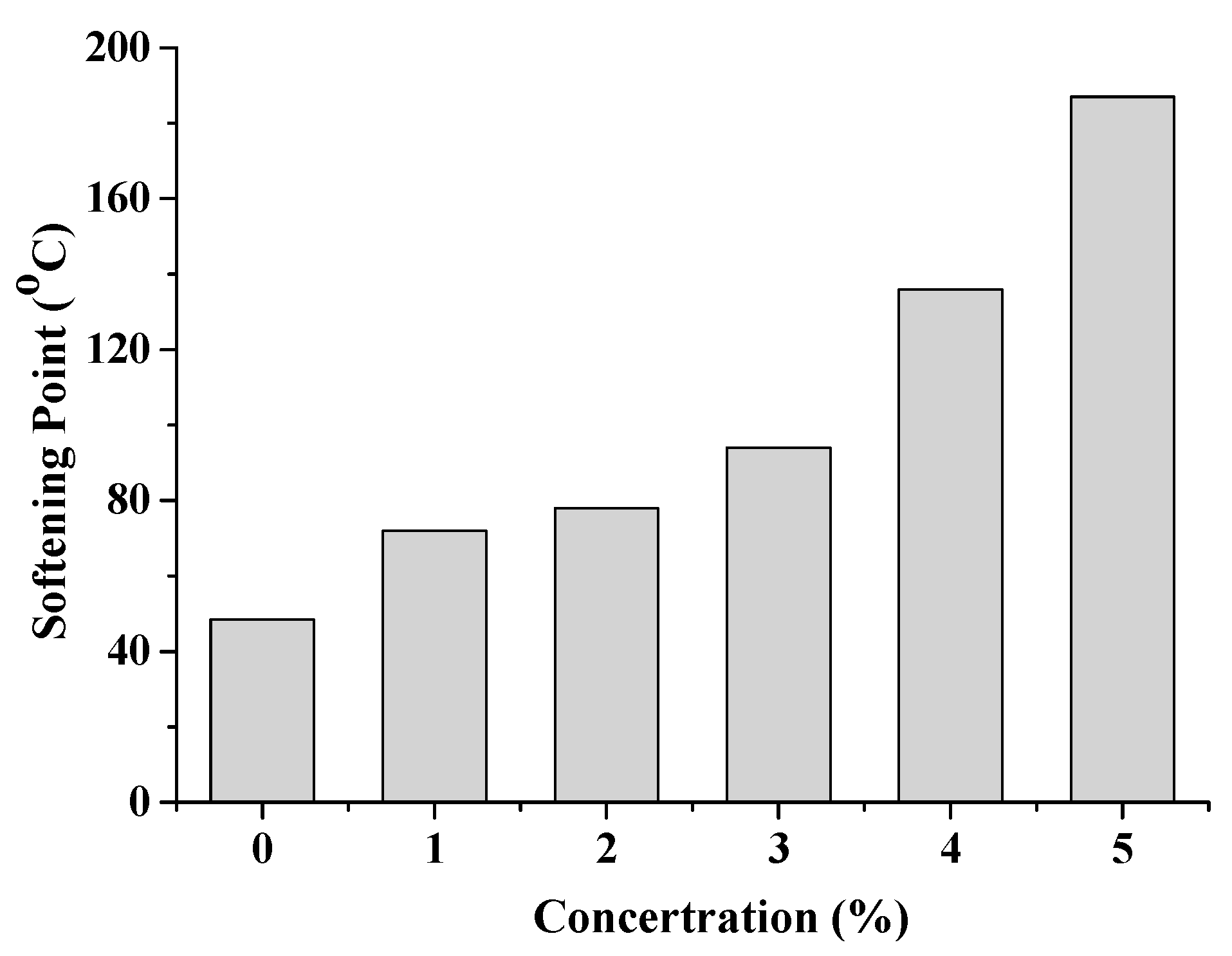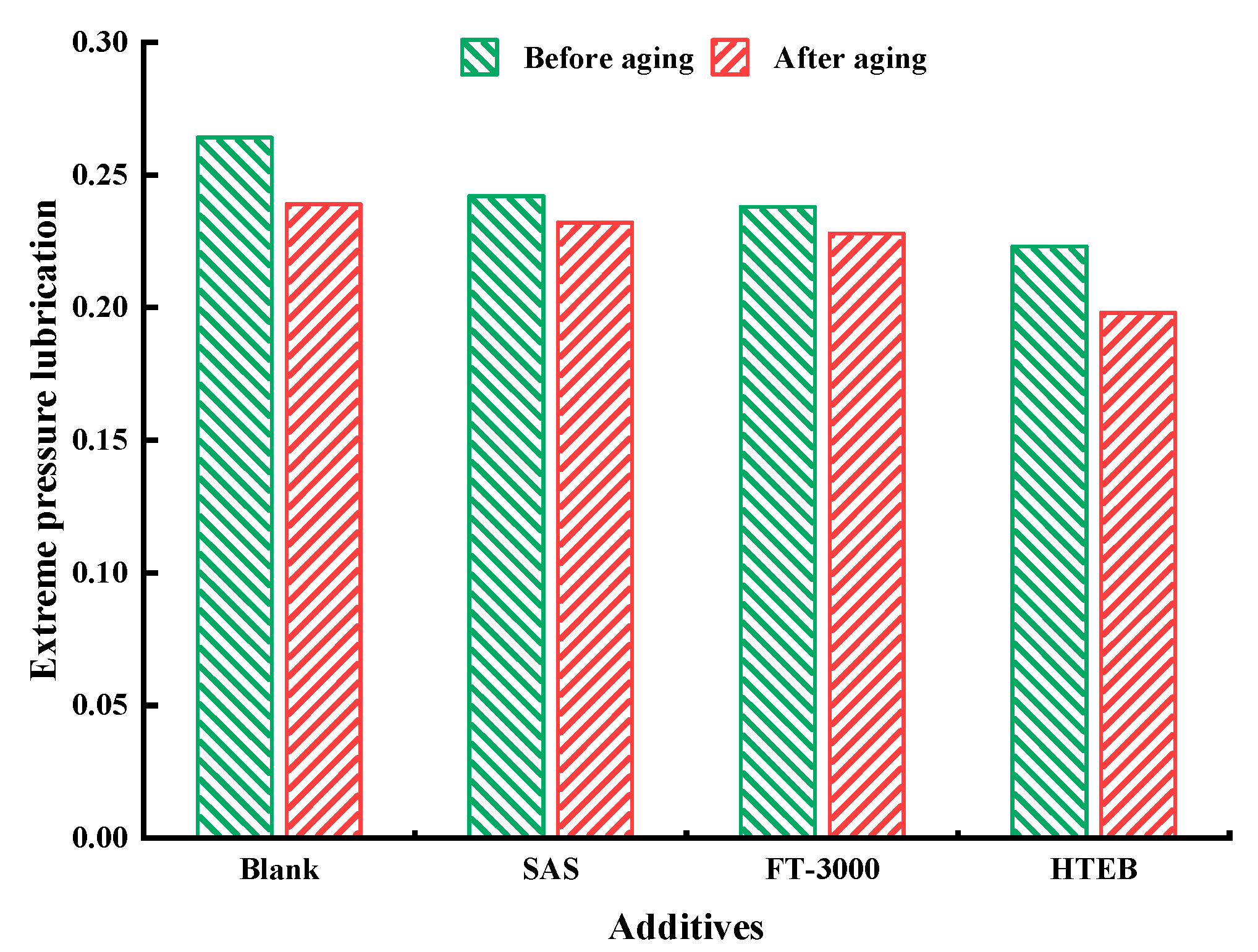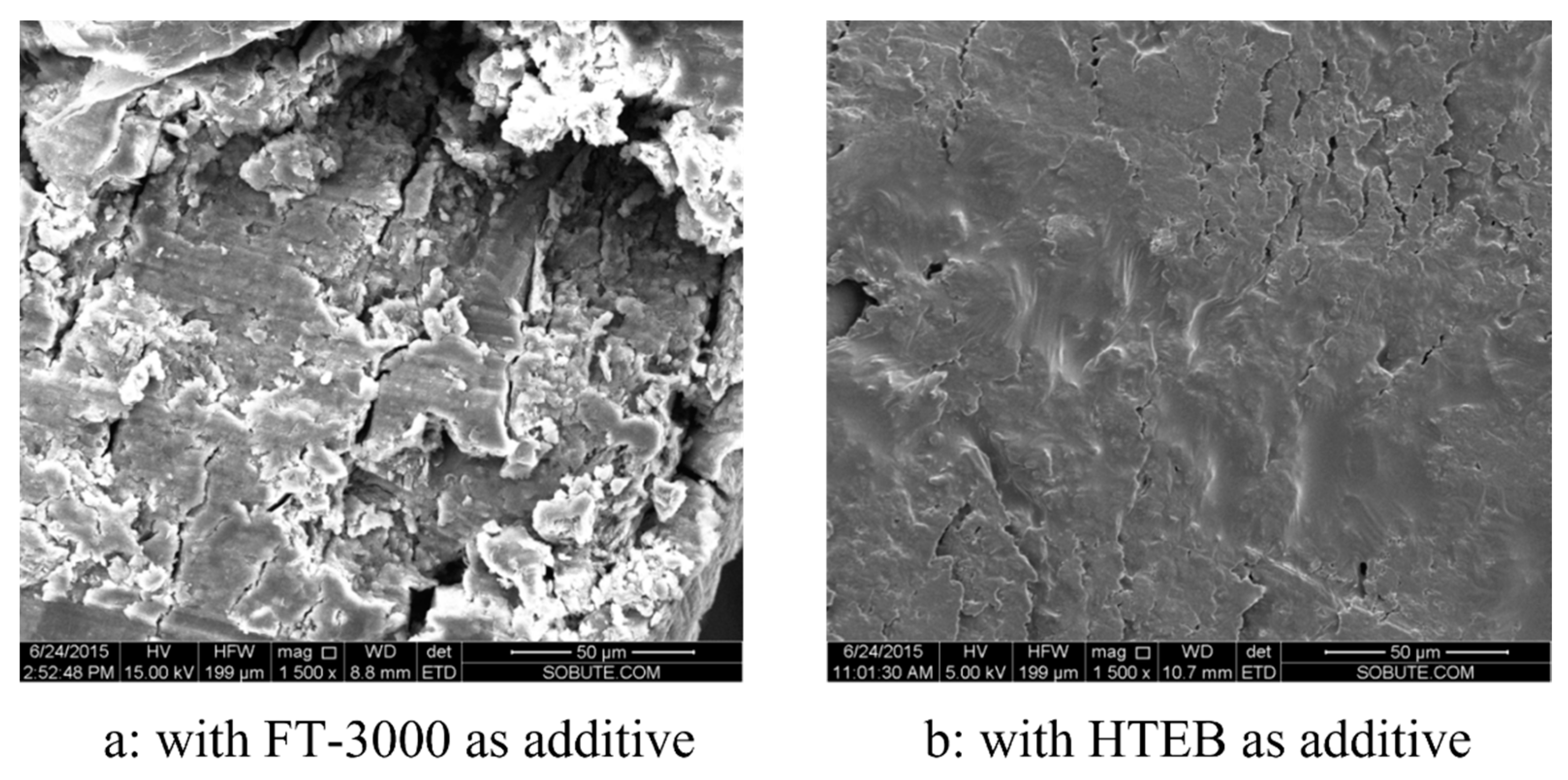Study on Plugging Microfracture by Using High-Temperature Emulsified Bitumen
Abstract
:1. Introduction
2. Experimental
2.1. General Procedure for Preparing High-Temperature Emulsified Bitumen (HTEB)
2.2. General Procedure for Obtaining Drilling Fluid
2.3. General Method for Obtaining Rheological Measurements of Drilling Mud
2.4. General Method for Obtaining Static Filtration
2.5. General Procedure for Obtaining Lubrication
2.6. General Procedure for Obtaining Core Inflation Inhibitory
3. Results and Discussion
3.1. The Microfracture Plugging Size Analysis
3.2. The Viscosity of Drilling Mud with Different Additives
3.3. The Static Filtration of Drilling Fluid with Different Additives
3.4. The Lubricating Properties of Drilling Fluid with Different Additives
3.5. Comparative Analysis of Microscopic Morphology after Plugging
3.6. The Core Expansion Properties of Drilling Fluid with Different Additives
4. Conclusions
- (1)
- When the content of WEP reaches 4%, it can effectively raise the softening point of the asphalt to 136 °C, which meets the specification requirement (120 °C). Between the nano and micro levels, the size of HTEB can comprehensively fill the microcracks, which indicates that HTEB can be used for drilling fluid modification.
- (2)
- The addition of different additives will increase the viscosity of the mud, thereby reducing the rheology of the mud, among which the influence of HTEB is the smallest, with almost no difference; at the same time, this degree of thickening can achieve a gradual reduction in the static filtration and ensure the stability of the drilling fluid performance.
- (3)
- The addition of different additives can effectively reduce the extreme pressure lubrication coefficient and viscous coefficient. Among them, the WEP in HTEB forms a kind of three-dimensional network structure to give a strong adhesion ability, and the emulsified asphalt substrate in HTEB has lubricity, meaning that the HTEB has the best lubricating performance.
- (4)
- Compared with the drilling fluids of FT-3000 and SAS, HTEB forms a high-quality mud cake, which has the advantages of a dense, thin, and smooth surface; the drilling fluid with HTEB can well fill the microcracks and inhibit the core expansion coefficient rate.
- (5)
- With the increase in dosage, the drilling fluid with HTEB always shows excellent performance, and the optimal dosage is 4% when in combination with economic cost considerations.
Author Contributions
Funding
Institutional Review Board Statement
Informed Consent Statement
Data Availability Statement
Acknowledgments
Conflicts of Interest
References
- Wu, X.; Wan, F.; Chen, Z.; Han, L.; Li, Z. Drilling and completion technologies for deep carbonate rocks in the Sichuan Basin: Practices and prospects. Nat. Gas Ind. B 2020, 7, 547–556. [Google Scholar] [CrossRef]
- Ashena, R.; Ghalambor, A.; Elmgerbi, A.; Hekmatinia, A.-A.; Mubashir, M. ‘Level-off cement plugging method to cure lost circulation verified with case studies. J. Pet. Explor. Prod. Technol. 2021, 11, 2777–2789. [Google Scholar] [CrossRef]
- Tabatabaei, M.; Taleghani, A.D.; Li, G.; Zhang, T. Shape Memory Polymers as Lost Circulation Materials for Sealing Wide-Opened Natural Fractures. SPE Drill. Complet. 2021, 36, 931–942. [Google Scholar] [CrossRef]
- Wang, Y.P.; Liu, X.J.; Liang, L.X.; Xiong, J. Experimental study on the damage of organic-rich shale during water-shale interaction. J. Nat. Gas Sci. Eng. 2020, 74, 103103. [Google Scholar] [CrossRef]
- Rana, A.; Arfaj, M.K.; Saleh, T.A. Advanced developments in shale inhibitors for oil production with low environmental footprints Areview. Fuel 2019, 247, 237–249. [Google Scholar] [CrossRef]
- Ni, X.; Jiang, G.; Li, Y.; Yang, L.; Li, W.; Wang, K.; Deng, Z. Synthesis of superhydrophobic nanofluids as shale inhibitor and study of the inhibition mechanism. Appl. Surf. Sci. 2019, 484, 957–965. [Google Scholar] [CrossRef]
- Ahmed, H.M.; Kamal, M.S.; Al-Harthi, M. Polymeric and low molecular weight shale inhibitors: A review. Fuel 2019, 251, 187–217. [Google Scholar] [CrossRef]
- Li, M.C.; Ren, S.; Zhang, X.; Dong, L.; Lei, T.; Lee, S.; Wu, Q. Surface-Chemistry-Tuned Cellulose Nanocrystals in a Bentonite Suspension for Water-Based Drilling Fluids. ACS Appl. Nano Mater. 2018, 1, 7039–7051. [Google Scholar] [CrossRef]
- Li, M.C.; Wu, Q.L.; Song, K.L.; Qing, Y.; Wu, Y.Q. Cellulose Nanoparticles as Modifiers for Rheology and Fluid Loss in Bentonite Water-based Fluids. ACS Appl. Mater. Interfaces 2015, 7, 5006–5016. [Google Scholar] [CrossRef] [PubMed]
- Aghdam, S.B.; Moslemizadeh, A.; Kowsari, E.; Asghari, N. Synthesis and performance evaluation of a novel polymeric fluid loss controller in water-based drilling fluids: High-temperature and high-salinity conditions. J. Nat. Gas Sci. Eng. 2020, 83, 103576. [Google Scholar] [CrossRef]
- Zheng, Y.; Amiri, A.; Polycarpou, A.A. Enhancements in the tribological performance of environmentally friendly water-based drilling fluids using additives. Appl. Surf. Sci. 2020, 527, 146822. [Google Scholar] [CrossRef]
- Wenjun, S.; Tao, S.X.; Fu, F.; Yue, W.M.; Zhao, Z.T. Research on the Drilling Fluid Technology for High Temperature over 240 degrees C. Procedia Eng. 2014, 73, 218–229. [Google Scholar] [CrossRef]
- Marriott, T.; Griffith, J.; Fyten, G.; Mallett, C.; Szutiak, G. Foamed conventional lightweight cement slurry for ultra-low density and low ECDs solves loss-circulation problem across coal formations: A case history. In Proceedings of the SPE Annual Technical Conference and Exhibition, OnePetro, Dallas, TX, USA, 9–12 October 2005. [Google Scholar]
- Long, L.; Da, Y.; Lei, L.; Zihang, Y.; Chao, H.; Cha, M.; Yuping, Y.; Xiao, L. Application of innovative high-density high-performance water-based drilling fluid technology in the efficient development and production of ultra-deep complicated formations in the Tian Mountain front block in China. In Proceedings of the Offshore Technology Conference Asia, OnePetro, Kuala Lumpur, Malaysia, 20–23 March 2018. [Google Scholar]
- Yuan, B.; Wood, D.A. A holistic review of geosystem damage during unconventional oil, gas and geothermal energy recovery. Fuel 2018, 227, 99–110. [Google Scholar] [CrossRef]
- Li, J.; Qiu, Z.; Zhong, H.; Zhao, X.; Huang, W. Coupled CFD-DEM analysis of parameters on bridging in the fracture during lost circulation. J. Pet. Sci. Eng. 2020, 184, 106501. [Google Scholar] [CrossRef]
- Huang, X.; Shen, H.; Sun, J.; Lv, K.; Liu, J.; Dong, X.; Luo, S. Nanoscale Laponite as a Potential Shale Inhibitor in Water-Based Drilling Fluid for Stabilization of Wellbore Stability and Mechanism Study. ACS Appl. Mater. Interfaces 2018, 10, 33252–33259. [Google Scholar] [CrossRef] [PubMed]
- ASTM D-2444; Standard Practice for Determination of the Impact Resistance of Thermoplastic Pipe and Fittings by Means of a Tup (Falling Weight). ASTM: West Conshohocken, PA, USA, 2021.
- SYT 6864-2020; Drilling Fluid Viscometer Calibration Method. National Energy Administration: Beijing, China, 2020.
- GB/T 16783.1-2014; Petroleum and Natural Gas Industries―Field Testing of Drilling Fluids―Part 1: Water-Based Fluids. National Standardization Administration of China: Beijing, China, 2014.
- SYT 6094-1994; Lubricant Evaluation Procedure for Drilling Fluids. National Energy Administration: Beijing, China, 1994.
- SY/T5946-1994; Polyacrylamide Potassium Salt for Drilling Fluids. National Energy Administration: Beijing, China, 1994.







| Additives | Treatment | AV /mPa·s | PV /mPa·s | Yp /Pa | Cutting/Pa | |
|---|---|---|---|---|---|---|
| Beginning | Final | |||||
| Blank | a | 31 | 28 | 1.5 | 1.5 | 1.5 |
| b | 20 | 17 | 3 | 1.5 | 2 | |
| SAS | a | 55 | 53 | 2 | 2 | 2 |
| b | 32.5 | 28 | 2.5 | 2.5 | 2.5 | |
| FT-3000 | a | 43.5 | 42 | 1.5 | 1.5 | 1.5 |
| b | 24 | 20 | 1.5 | 1.5 | 1.5 | |
| HTEB | a | 37 | 36 | 1 | 1 | 1 |
| b | 24 | 20 | 1.5 | 1.5 | 1.5 | |
| Additives | Static Filtration/L | |
|---|---|---|
| Blank | - | 0.0258 |
| SAS | 3% | 0.0234 |
| FT-3000 | 3% | 0.0218 |
| HTEB | 2% | 0.0221 |
| 3% | 0.0188 | |
| 4% | 0.0176 | |
| 5% | 0.0172 | |
Disclaimer/Publisher’s Note: The statements, opinions and data contained in all publications are solely those of the individual author(s) and contributor(s) and not of MDPI and/or the editor(s). MDPI and/or the editor(s) disclaim responsibility for any injury to people or property resulting from any ideas, methods, instructions or products referred to in the content. |
© 2024 by the authors. Licensee MDPI, Basel, Switzerland. This article is an open access article distributed under the terms and conditions of the Creative Commons Attribution (CC BY) license (https://creativecommons.org/licenses/by/4.0/).
Share and Cite
Yang, L.; Chen, X.; Gu, L.; Chen, Y.; Shi, S. Study on Plugging Microfracture by Using High-Temperature Emulsified Bitumen. Coatings 2024, 14, 387. https://doi.org/10.3390/coatings14040387
Yang L, Chen X, Gu L, Chen Y, Shi S. Study on Plugging Microfracture by Using High-Temperature Emulsified Bitumen. Coatings. 2024; 14(4):387. https://doi.org/10.3390/coatings14040387
Chicago/Turabian StyleYang, Liang, Xiang Chen, Linhao Gu, Yan Chen, and Shuang Shi. 2024. "Study on Plugging Microfracture by Using High-Temperature Emulsified Bitumen" Coatings 14, no. 4: 387. https://doi.org/10.3390/coatings14040387
APA StyleYang, L., Chen, X., Gu, L., Chen, Y., & Shi, S. (2024). Study on Plugging Microfracture by Using High-Temperature Emulsified Bitumen. Coatings, 14(4), 387. https://doi.org/10.3390/coatings14040387






